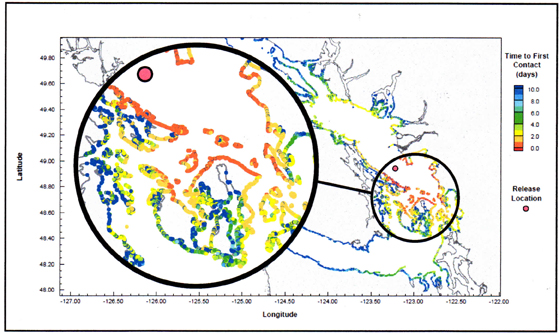A new threat to Salish Sea health
— by Michael Riordan —
Hardly two years after we learned about the proposed Gateway Pacific coal terminal at Cherry Point, the San Juan Islands are facing yet another threat of vastly increased fossil-fuel transport through our waters. And this one could ultimately prove far more damaging than what is posed by titanic coal carriers.
In December, Kinder Morgan LLC submitted plans to Canada’s National Energy Board for its Trans Mountain Pipeline Expansion Project, which would increase capacity from 300,000 to 890,000 barrels per day — exceeding even that of the proposed Keystone Pipeline in the nation’s mid-section. Almost all of the extra oil would be put on tankers near Vancouver and shipped via Haro Strait, increasing the number of loaded tanker transits from about one per week to more than one per day.
These added tankers would substantially raise the undersea noise levels already impacting the critical habitat of our endangered Southern Resident Orca whales, which feed upon Chinook salmon along San Juan Island’s west shore. And the additional tankers would dramatically increase the chances of collisions and groundings in Georgia Strait and Haro Strait, according to the recent Vessel Traffic Risk Assessment prepared by George Washington University researchers.
If not quickly contained, a major oil spill in or near our waters could well prove catastrophic to the San Juan Islands. Computer simulations summarized in the Kinder Morgan proposal indicate that spills in these Straits would otherwise begin coating our shores within a day after such a release — especially on Orcas, San Juan, Stuart and Waldron Islands (See maps linked at bottom of this article). If a spill were to occur in conditions of high winds or currents, rapid containment may prove difficult if not impossible. The results of a large spill could be disastrous, changing life on the islands forever.
And the threat unfortunately doesn’t end there. These tankers carry tar-sands oil from Alberta, diluted with volatile liquids so that it can flow through pipelines. When released into marine waters, this diluted bitumen, or “dilbit,” will separate out into its components; the volatiles evaporate and a portion of the heavy, sticky bitumen can sink to the sea floor.
Something similar happened in Michigan’s Kalamazoo River in July 2010. An Enbridge pipeline ruptured, releasing nearly a million gallons of dilbit into a tributary. To nearly everyone’s surprise, a substantial fraction sank to the river bottom, coating it for miles downstream. Typical oil-spill containment and clean-up methods, which rely on the oil remaining afloat, were of little help. Nearly four years later, Enbridge is still trying to clean up the sticky mess, and the costs are approaching $1 billion.
If such a release were to occur in Salish Sea waters, the results could be far worse, given the strong diurnal tides that course through our islands. No known containment method will suffice to corral submerged oil. Even tracking where it goes will be difficult — never mind removing it from the sea floor, where Pacific sand lance, a favorite salmon food, are known to live buried in the shifting sands.
As we approach the 25th anniversary of the devastating Exxon Valdez oil spill, which occurred in Alaska’s Prince William Sound on March 24, 1989, San Juan Islanders need to wake up and take notice of this new threat to our beloved environment and the tourist economy that depends on it remaining as it is. Such a disaster could happen again here.
This Saturday, March 15, knowledgeable speakers will address this threat in a pair of talks cosponsored by the Friends of the San Juans and the San Juans Alliance, beginning at 12:30 pm in the Episcopal Parish Hall. Marine biologist Gary Shigenaka, an oil-spill expert, will address how the various forms of crude oil behave in marine environments. And Julie Knight, the Executive Director of the Islands Oil Spill Association, will discuss local spill-response preparedness.
On Sunday, March 23, the award-winning documentary film “Black Wave: The Legacy of the Exxon Valdez” will air the Orcas Senior Center at 3:00 pm. Come and see what an enormous, devastating oil spill can look like.
Admission to both events is free but donations will be gratefully accepted.
Click here to see KinderMorgan Maps Computer simulations: showing the likely impacts on the San Juan Islands of an uncontained oil spill in Georgia Strait: (top) probability that various shorelines will be coated with oil; (bottom) time before the spill reaches these shores. (Source: Kinder Morgan proposal for the Trans Mountain Pipeline Expansion Project, Section 5: Risk Assessment and Spill Management)
Michael Riordan lives on Orcas Island, where he writes about science, technology and public policy. He is a founding member of the San Juans Alliance, a coalition of island environmental groups opposed to the proposed Gateway Pacific coal terminal.
**If you are reading theOrcasonian for free, thank your fellow islanders. If you would like to support theOrcasonian CLICK HERE to set your modestly-priced, voluntary subscription. Otherwise, no worries; we’re happy to share with you.**








